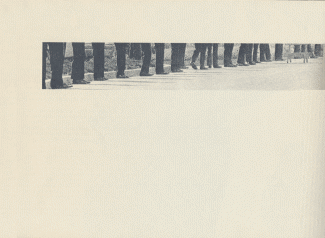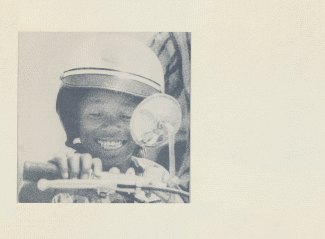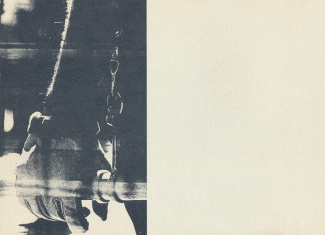
3. The Complaints
The three police practices complaint centers have in a total of 72 "office-months" taken 734 complaints of police abuses of their legal authority. The rate of complaints received at the offices has varied from month to month, though there has been a gradual increase in the totals. (See Chart I, next page.)
The complaint rate too reflects the vagaries of operation of the offices. The Watts center was opened with substantial publicity, and the first director was uncritical in accepting complaints -- this accounting for the unmatched number of complaints.
Beginning in January, 1967, the three centers settled down with more or less permanent staffs and procedures. (The Watts office in particular was unsettled, lacking a director for November, 1966.) From that time forward, the complaint rates of the offices tended to level out, and to parallel each other. To some extent, the rate of complaints reflects the rate of police activity -- the more arrests made, the greater the number of complaints.
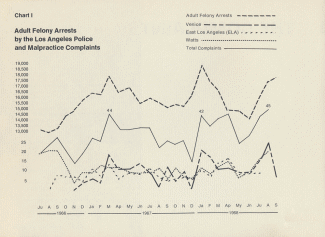
Chart I: Adult Felony Arrests by the Los Angeles Police and Malpractice Complaints
In the first months of operation in Watts, complaints were accepted uncritically, or virtually so, and forwarded to officials. The offices were, in theory, merely to assist complainants in filing complaints with the proper government agencies; such evaluation as was called for would be made by the authorities. This policy was changed to permit initial screening by first the director, and later by the ACLU's legal staff. Screening of complaints, coupled with investigation permitted, the offices to forward only those complaints which seemed to have merit on their face.
The rationale was one of establishing credibility for the offices with official agencies. If the complaints were of more substance, it was believed, they would receive more serious attention. In fact, there have been so few substantiated complaints that no meaningful evaluation of the policy change can be made.
Initial screening at the centers or by the ACLU's legal staff determined that in 134 of the 734 cases handled, there was no malpractice, or that police actions were warranted by the facts as the complainant related them. (Ten Venice cases did not involve police at all and have been excluded.) Forty-five files were incomplete, the complainant having decided to drop the matter; five files were transferred from one center to another, and new files opened. This left a balance of 540 cases analyzed in which there was substantial belief that police malpractice occurred.
There were 639 complainants in the 540 cases. In 82, there were two or more victims who related their grievance to the centers, a proportion which suggests that police malpractice is not entirely a covert business.
Men outnumbered women about four-to-one. (See Table I.) Well over half of those who complained and for whom ages were given on the complaint forms were between 17 and 25, this group the focus of the greatest attention by police, this age group too the one most responsible for crime. [1]
Because the three offices were deliberately opened in the heart of minority communities, Negroes and Mexican- Americans are a vast majority. Nonetheless, there were 118 "Anglos," that is, Caucasians other than Mexican- Americans. Negro complainants totalled 314, Mexican- Americans 174.
Unexpectedly, only 150 of the 376 complainants whose marital status is known were single. (The complaint forms do not ask the marital status of complainants; this information was derived from the statements or answers to other questions.) Thirty-seven were divorced, two widowed, leaving a balance of 176 married persons.
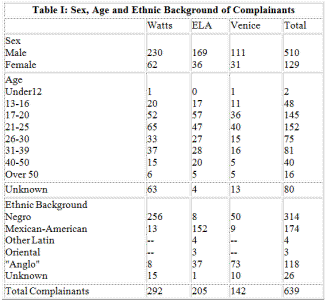
Table I: Sex, Age and Ethnic Background of Complainants
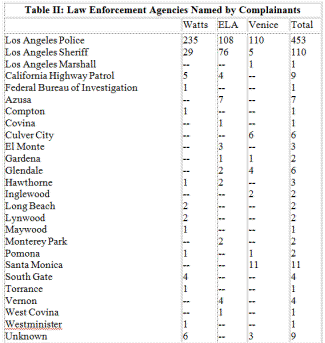
Table II: Law Enforcement Agencies Named by Complainants
The disproportion of married complainants may be an indication that those who do complain to the centers are persons who feel that they have some stake in the community -- marriage, a family, a home -- and are not completely alienated (anomie). The complainants then may not be an accurate sample of all those who believe themselves victimized by police, for it is generally held that single men, under 25 are the focus of most police activity, and the victims of most police malpractice.
This may still be true, the disproportion of married persons the result of unwillingness on the part of the completely unattached single men to bother to complain. Their complaints may be valid, but their apathy and disbelief in the value of filing complaints would tend to cause them to let the matter drop.
Officers representing twenty-five law enforcement agencies were named in the complaints taken. (See Table II.) The Los Angeles Police Department was named 453 times, the Los Angeles County Sheriff's Department 110. Only five other departments were cited more than five times: Santa Monica (11); the California Highway Patrol (9); Azusa (7); Culver City and Glendale (6 each).
The large number and percentage (70 percent) of LAPD citations reflects three factors: that agency is the most active in Los Angeles county, policing the largest city; all three offices are located within the city limits and are more accessible to residents of the city; the bulk of the county's minority group population -- presumably that group most victimized by the police --lives within the city.
That some departments are named infrequently or not at all cannot be taken as an indication that they are free of police malpractice, or that their complaint procedures are such that the services of the centers are not needed.
In those cases where it was determined by the centers that malpractice of some sort took place, 1,356 officers were actively involved, either physically abusing the complainant, making the arrest, or participating in the ostensibly illegal activity. (See Table III.) Most of these, 806, were not identified.
As of December 31, 1966, there were 12,646 sworn officers in Los Angeles county's 48 law enforcement agencies. Even allowing for the identification of a single officer involved in more than one incident, it would appear that approximately 10 percent of sworn law enforcement personnel have been identified as actively engaging in some form of police malpractice. Actually, the percentage may well be higher, for very few complaints are lodged against detectives and other plainclothesmen. The Los Angeles Police Department, for example, has only 50 percent of its sworn personnel assigned to the Patrol Bureau, the members of which are the most frequently cited by complainants. [2]
In addition to the active officers, 613 others were cited by the complainants as being passive spectators to the malpractice. In effect, they are witnesses who will not tell departmental superiors, nor testify in court about the alleged malpractice.
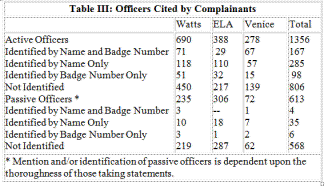
Table III: Officers Cited by Complainants
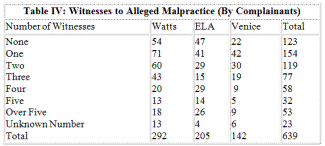
Table IV: Witnesses to Alleged Malpractice (By Complainants)
The incidents took place in a variety of locations, 409 outdoors. But 126 took place in private homes, many of these actions involving illegal searches and seizures. Physical brutality was the most frequent complaint among the 15 I reports of malpractice in the jailor stationhouse, and the 64 instances when the malpractice took place in a police vehicle.
Of the 785 locations mentioned by complainants (some were victimized in more than one place), 365 took place outdoors, other than on the victims' own property. In most instances, these were on the city streets, often begun as a routine field interrogation. [3]
According to the complainants, the incidents took place most often at night, 375 between the hours of 6 p.m. and 6 a.m. By comparison, 141 took place between 6 a.m. and 6 p.m. Generally, the later the hour of the day, the greater the number of incidents: 105 reportedly took place between 6 and 9 p.m.; 161 in the next three hours; 170 between midnight and 3 a.m.; and 39 between 3 and 6 a.m. This curve generally parallels police activity.
In the greatest number of cases, there were witnesses. Only 123 complainants had no one to support their statement. Another 154 could report only one witness, but 362 had two or more witnesses to corroborate their story. (See Table IV.) Some of these witnesses, however, were themselves arrested, and could not be considered independent or unbiased. The significant fact remains that malpractice is not, apparently, a furtive thing confined to the stationhouse where back room beatings were once commonplace. [4]
From the accumulated cases, it would appear that police malpractice occurs in some proportion to the frequency of police-citizen contacts. Most arrests are made at night, for example; most malpractice complainants report their brush occurred at night. Most police-citizen contact takes place in public; most of the reported cases of malpractice occurred in public. Most police patrols -- especially in the ghettos -- are by pairs of officers, with additional pairs answering radio calls if assistance is needed; most of the complainants mentioned that at least one active and one passive officer were involved. Police focus their attention on young men; the majority of complainants were young men.
In short, the cases gathered at the centers indicate that police malpractice in one or another form is a routine part of police work. How great a percentage of cases results in police abuse of authority is not known -- the centers cannot be presumed to get reports of all instances of malpractice. It is clear, however, from the reports surveyed, that police malpractice may occur at any time, and in any place, and apparently without the officers feeling any great fear of punishment despite the large number of police and civilian witnesses. [5]
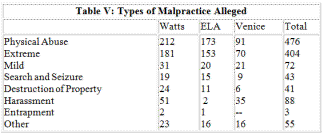
Table V: Types of Malpractice Alleged
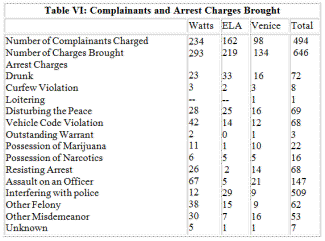
Table VI: Complainants and Arrest Charges Brought
The malpractice complained of varied from extreme physical abuse -- defined as two or more blows by a police officer on an unresisting civilian -- to harassment; many reported more than one abuse. The largest proportion of the complainants alleged physical mistreatment; there were 476 complaints from the 636 who gave statements to the centers. (See Table V.) In part, this disproportion may be a reflection of the fact that those who have been less grievously injured or inconvenienced are more willing to shrug the matter off. In part too, many people in the ghettos simply do not know their rights, assuming that police have a right, for example, to search their homes or automobiles without obtaining warrants or making arrests; assuming that police may legally do these things, victims do not complain.
Of those who complained of being hit unnecessarily (judging from the complaints, it would appear that those who do resist arrest and are struck as a result do not file complaints), 236 were injured seriously enough to require medical attention. Four complaints were filed by the next-of- kin of people shot by police; 11 persons had teeth broken; 23 had broken bones. The balance was sprayed with Mace, or bruised, or suffered lacerations sometimes requiring stitches.
A majority of the complainants were charged by police with crimes though the greatest number of police-citizen contacts do not result in arrests. This disparity, again, is best explained by the fact that apparently only the most aggrieved or most desperate victims of police abuse will overcome the sense of futility endemic in the ghettos or their bitter hostility to governmental agencies and take some action.
Of the 639 people who filed complaints at the three centers, 494 were faced with criminal prosecutions. (See Table VI.) Some had to contend with multiple charges, frequently a combination of three: disturbing the peace, resisting arrest, and assault on an officer.
In all, 646 charges were entered against the 494 arrestees. Significantly, only 100 of these were felonies, that is, crimes deemed by the Penal Code to warrant prison sentences of a year or more. (Twenty-two of these felonies were possession of marijuana counts, a charge which police and jurists alike consider less grave, though it is, by law, a felony.)
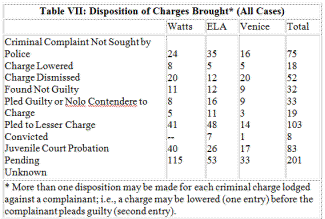
Table VII: Disposition of Charges Brought* (All Cases)
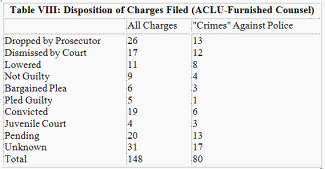
Table VIII: Disposition of Charges Filed (ACLU-Furnished Counsel)
The largest number of crimes allegedly committed took place only after police arrived on the scene. In most cases, those arrested find themselves booked for no substantive crime (burglary, robbery, etc.) but only for "crimes" against police. [6] There were, of the 646 total charges lodged, 147 counts of assault on an officer, 68 of resisting arrest, and 50 with interfering with a police officer. Not uncommonly, those people who feel themselves unnecessarily stopped by police, or the victims of a roust or harassment will protest, and even resist; they are guilty of resisting arrest or assault on an officer. The fact that they may be guilty of these crimes does not, however, mitigate the fact that they were stopped originally for no law enforcement purpose.
Those who protest police interrogations, or who insist upon their rights run the risk of further criminal charges. If they are loud, or return verbal abuse with verbal abuse, they may be booked as drunks -- 72 were -- or for disturbing the peace (69 such charges).
Not all of these charges result in convictions, or even criminal complaints. Seventy-five of the charges for which the disposition was known were dropped by police. In 52 instances, charges were dismissed by the courts, and in 32 cases, defendants were found not guilty of the counts brought against them. (See Table VII.)
In all, 159 of the 445 counts for which the disposition is known were terminated with some form of complete exoneration. In view of the fact that so many of the "crimes" police allege ostensibly took place in the presence of arresting officers, this would appear to be a comparatively high exoneration rate. [7]
The filing of complaints with official sources could only be successful, the ACLU had learned, if alleged victims were cleared of all criminal charges arising from the incident. Found guilty, a complainant had little or no chance of successfully sustaining his complaint, even when the criminal charge did not excuse the malpractice. Authorities tended to equate guilt on a substantive criminal charge -- auto theft, for example -- with responsibility for the police use of excessive force.
Moreover, the arresting officers would file charges of resisting arrest or assault on a police officer so as to excuse the bruises or even hospitalization of a person they had arrested. To substantiate the complaint of brutality, it was necessary first to establish that the complainant was, indeed, an innocent victim.
To meet this requirement, the ACLU has provided attorneys for 100 persons who brought complaints of police malpractice to the centers after being arrested. These ACLU volunteer attorneys have substantially altered the usual results in cases such as these handled by other private attorneys or by the public defender. (See Table VIII.)
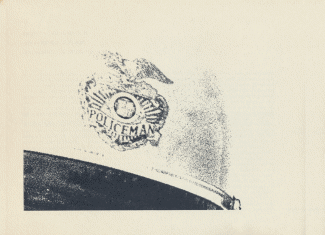
The 100 defendants faced a total of 148 charges ranging from vehicle code violations to assault on an officer, a felony carrying a maximum penalty of a ten-year prison sentence upon conviction.
The disposition of 31 of these charges is unknown; 20 are still pending, leaving a total of 97 known dispositions. In only 28 cases -- approximately 29 percent of the dispositions -- was the defendant guilty, either by plea or court conviction, or juvenile court finding. This compares favorably to the approximately 85 percent conviction rate which prosecutors maintain in California.
Eleven charges were dropped, to be replaced by (usually) lesser counts; six were disposed of with negotiated pleas of guilt to lesser offenses.
Twenty-six of the charges were never prosecuted by the city or district attorney on the ground that there was insufficient evidence to convict. Seventeen other charges were dismissed by the court after the prosecution's case was presented. Tn nine cases, jury or judge found the defendant not guilty. Approximately 52 percent of all charges ended with the exoneration of the defendant.
Significantly, the appearance of ACLU volunteer attorneys served to restrict the use of negotiated pleas, that is, deals privately made between defense and prosecution wherein the defendant pleads guilty to a lesser charge in exchange for the state dropping the remaining counts. The negotiated plea is frequent in criminal courts, albeit little discussed in law school or the legal periodicals. [9] Only in the most severe cases, where the offer of a negotiated plea will keep a defendant from the state prison, will ACLU volunteer attorneys recommend that their clients "cop a plea."
A result is that charges unsuccessfully used to force bargained pleas will be lowered to what attorneys term "the lessor included offense," that is, a crime subsumed by a more serious charge. Assault becomes misdemeanor battery; riot becomes disorderly conduct or failure to disperse; assault on an officer is dropped to interfering with an officer. There were 11 such motions made by the prosecution, presumably to bring the charge into line with the actual evidence against a complainant.
In the "crimes-against-police" category -- the centers make a special effort to provide counsel when only these counts are lodged against complainants -- there is some difference in the percentage of cases which result in convictions. Forty-two percent of the charges were sustained by findings of guilt, pleas, pleas to a lessor count, or juvenile court petitions. Fifty-eight percent of the known dispositions ended with dismissal or exoneration of these "crimes" committed only after police arrive.
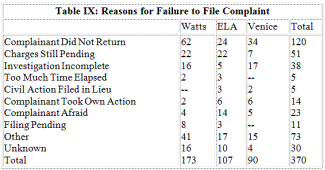
Table IX: Reasons for Failure to File Complaint
http://www.rapeutation.com/lawenforceme ... _small.gif
Table X: Results of Complaints Filed with Official Agencies
Slightly less than 500 of the 639 total complainants were confronted with criminal charges at the time they came to the malpractice centers. Not all were provided with ACLU volunteer counsel; most secured private attorneys or were represented by the public defender. Whoever provided their defense, 253 complainants reported the outcome of their trials to the centers; significantly, 92 of these for whom the outcome is known were completely cleared of all charges. Again, this compares favorably with statewide conviction rates averaging about 85 percent.
The criminal defense is only the first step in helping complainants secure redress of their grievances. Two other actions remain: the filing of formal complaints with the law enforcement agency; and/or the filing of civil suit in either the state or the federal courts. The first is the responsibility of the directors of the centers, once the court case has been settled. The second is the responsibility of private counsel, retained by the victim. [10]
By September 1, 1968, the three offices had filed 165 formal complaints with law enforcement agencies. For a number of reasons, in 372 cases complaints were not filed. (See Table IX.)
In part, the failure to file complaints, especially in the first months of operation in Watts, was the responsibility of the centers where procedures had not been clarified, and policies not made formal. In part too, the large number of failures-to-file because the complainant failed to return or follow up his initial complaint is the responsibility of the center directors; in the first period of operation, the understaffed director of the Watts office in particular was unable to follow through.
It is significant -- and perhaps indicative of the attitude of those who do come to the centers -- that few complainants refused to file formal statements with law enforcement agencies because of fear. (It is widely believed that fear of retaliation -- real or imagined -- holds down the number of official complaints lodged.) It would appear that those who do complain to the centers are less afraid, or, having gone so far, believe that the filing of a formal complaint is no more a risk.
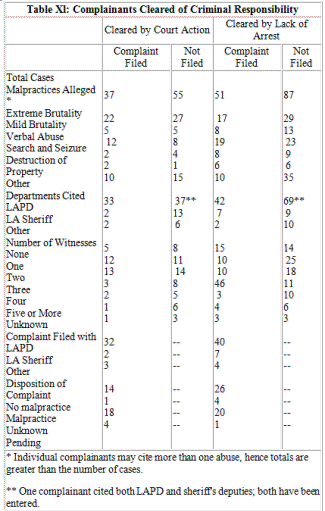
Table Xl: Complainants Cleared of Criminal Responsibility
The centers have filed a total of 165 complaints for as many victims of police malpractice: 128 with the LAPD, 24 with the sheriff, and 18 with various other agencies. In 84 cases, police investigators have found for the officers alleged to have committed the malpractice; in just six - all Los Angeles Police Department - have the complainants been sustained. (See Table X.) Forty-one complaints are still pending, some filed more than 18 months before the completion of this report. The disposition of 34 is unknown, largely the result of the Los Angeles Police Department's refusal to notify the centers of the department's findings. While the Los Angeles Sheriff's Department will forward carbon copies of correspondence to the centers, the LAPD's refusal makes difficult the problem of learning eventual outcomes; complainants move frequently in the ghettos and barrios, often have no telephones, and eventually choose to drop the matter as useless.
Of the 90 cases for which the finding is known, only six, or 6.6 percent, resulted in decisions favoring the complainant. In no case was the punishment made known to the victim.
Whatever the decision, it is not quickly reached. Of the six complaints sustained, the average time from filing of the complaint to the receipt of the department's letter of notification was 116 days, just four days short of four months. The longest time lapse was 208 days (from February 23 to September 19, 1967), the shortest 69 days (August 10 to October 18, 1967). The median or midpoint between shortest and longest periods was 94 days.
For those complaints which were not sustained, the time lapse from filing to notification was considerably shorter, 69 days. The longest period was 152 days, the shortest 22. The median was 73 days.
The six cases sustained did not involve a significantly greater number of witnesses and, in any event, the complainant submits the names of his witnesses when he files his complaint. Without access to departmental investigation files, it is impossible to determine just why it takes significantly longer to sustain complaints than it does to deny them.
However long the investigation may take, the evaluation of complaints in Los Angeles county is most gravely questioned by the outcome of complaints filed on behalf of those who are innocent of criminal responsibility.
There were 88 such complainants, either individuals who were not arrested in their confrontation with police (51), or who were subsequently cleared of all criminal charges lodged against them (37). Of these 88, 52 complained of physical abuse in some degree, 31 of verbal abuse, 18 of property destruction or illegal searches and seizures. (See Table XI.)
In 142 other instances, the victims chose not to file complaints, fearing retaliation in some cases, satisfied that they have been cleared of criminal charges and willing to let the matter rest.
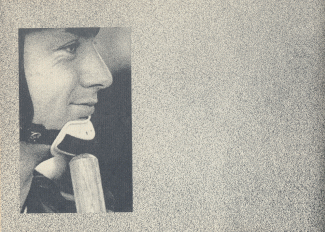
Complaints were formally filed with law enforcement agencies on behalf of 88 exonerated arrestees: 75 with the Los Angeles Board of Police Commissioners; nine with the county sheriff; four with other departments. In 45 cases, the results of the police disposition are known. In only five instances has the agency found that its officers did overstep their legal authority. At the same time, these agencies have upheld the actions of the officers in 40 cases, despite the fact that in all 40 cases, the complainants were innocent of all criminal charges. In these instances at least, the police cannot explain away the overzealous acts of officers as necessary to make a legal arrest, to bring a criminal to bar. Neither will a conviction for disturbing the peace serve to mask a defendant's bruises. (Legally, there is no reason why they should, but the practical effect of a conviction on any charge is to validate whatever action the police may take.)
The significance of this 11 percent rate (5 of 45) of finding for the complainants is that it is so small. Not burdened by arrests, or better, for purposes of argument, validated by exonerations from a judge or jury, these complaints would seem to be most easily sustained. Forty-two of the 88 complainants had two or more witnesses to the police action; in view of the fact that in many cases the witnesses' accounts were responsible for exonerations at criminal trials, one might imagine they would be credible to police investigators as well. They are not.
Third party review -- a judge and jury -- resulted in clearing 37 people who subsequently filed departmental complaints; exoneration of the arrestees had the effect of criticizing the police, at least by implication. Despite this impartial weighing of the witnesses' statements as a precedent, police investigators are only slightly more inclined to find the officers at fault.
The complaints found to have merit by police included those of:
1) A 46-year-old Mexican-American called a "no good dirty, fuckin' liar" by one Los Angeles police officer, booked for auto burglary, bailed out after posting $2,750, then cleared of the felony charge when the district attorney declined to file against him in Superior Court. His complaint of abusive language was sustained, despite the absence of civilian witnesses, undoubtedly after the partner officer -- who was reportedly at odds with the arresting officer -- corroborated the complainant's statement.
2) A 20-year-old Mexican-American who protested when Los Angeles police officers walked into the midst of his backyard party, deliberately kicked over beer cans, and told the complainant, "Stop acting like an asshole." There were five witnesses.
3) An 18-year-old Mexican-American with a witness to the physical and verbal abuse he suffered at the hands of an off-duty Los Angeles policeman serving as a security officer at a local drive-in. The police commission absolved the officer of using derogatory language, but reported, "The investigation disclosed that he used improper tactics to maintain control of you following your arrest." This is the only person convicted who had his complaint sustained.
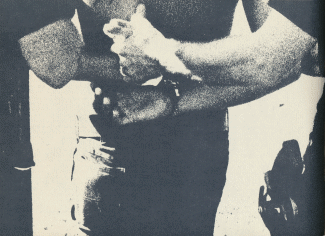
4) A husband and wife who complained that Los Angeles police did not respond promptly to repeated phone calls first to report their 7-year-old daughter was missing, and then to report she had been found with her clothes torn, possibly a victim of a sexual assault. Eight months after the complaint was filed, the department acknowledged a car had not been properly dispatched when the man and woman first called.
5) A 38-year-old Negro arrested by police for participating in a scuffle on the street, handcuffed, then thrown bodily against a cement wall, a parked car, a water fountain; then deliberately kicked in the side by a Negro Los Angeles policeman in front of two witnesses. Subsequently treated for his injuries at a hospital, the victim was then released.
6) A 29-year-old Mexican-American beaten by Los Angeles police officers who was treated for broken bones and twice underwent operations to drain excess fluid from his testicles. A civil suit is pending in this case.
They were the six whose complaints were sustained. Eighty-four others were denied. More than 370 victims, for one or another reason, did not file complaints.
And throughout the county there are hundreds of other victims of police abuse of authority who have never come to the three police practices center. For them the lack of redress, and the inevitable lack of faith in a system of justice is even more a grievance.

